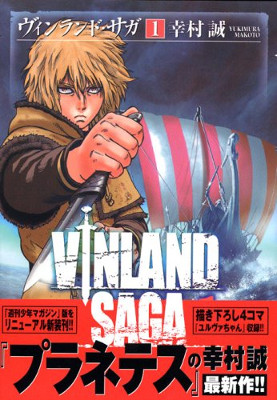Vinland Saga (2006)
[ヴィンランド・サガ]
Volume 1

Author/Artist: Makoto Yukimura
Publisher: Afternoon KC
Synopsis:
The young Icelandic mercenary Thorfinn fights in the army of his father's killer in search of an opportunity to take revenge.
Story/Characters:
This is another one of those series that managed to catch my eye on the bookshelves, but it wasn't until I saw the anime that I made a point to start collecting the manga. One of my history credits back in college was a course about the Viking era, so the setting holds particular interest for me. As a history buff, I appreciate all the work Yukimura has put into the series. While there are certainly fantastical elements to it, this is one of the more accurate depictions of medieval life and warfare out there. There's no prettying up the hard times and rampant brutality, which I appreciate.
We have a fairly typical revenge story as the base, with our wild dog of a hero and his wily captain. Askeladd is by no means a good person, but, boy, is he ever entertaining to watch in action. In contrast, our protagonist Thorfinn is so monomaniacal that if we didn't have such an excellent foil, he wouldn't be all that interesting. (Don't let that description put you off, though. This is just the starting point in the character's journey.) During Thorfinn's duel with Askeladd, we establish not only has he been at this a long time, but that no matter how much his skill improves, he's still too impulsive and easy to provoke to stand a chance of getting his revenge. We also draw a parallel between Thorfinn's stubborn pride and that of a former noblewoman sold into slavery. A conversation between him and said slave provides the segue for a flashback ten years prior. We find a young Thorfinn in his native Iceland being regaled by none other than Leif Eriksson. His stories of Vinland inspire the boy, though most of the other children aren't buying it. That evening, Leif and Thorfinn's father Thord discuss the declining situation in Iceland with the winters getting progressively colder. (I know the officially translation renders the name as "Thors", but I remember that jumping out to me as odd and when I did some research on the historical Thorfinn, I found that it was in fact "þórðr" and "Thord" is the more common rendering.) The next morning, while Thorfinn's sister Ylva is helping Thord clear snow, she stumbles on a dying slave suffering from severe frostbite among other things. It turns out that the slave ran away from the landowner Halfdan from a neighboring village and that selfsame Halfdan has shown up to reclaim his property. We get to see the lengths Thord will go for the sake of his ideals, which is a strong establishing moment. Halfdan for his part, while cruel, isn't entirely unreasonable. Keep that on the back burner for later. We also see a fair bit of Ylva's character and it's fun contrast her with her far more idealistic father. Meanwhile, the situation in England takes a turn for the worse for the occupying Danes, prompting the Jomsvikings to be dispatched and a group of them show up in Iceland to pick up an old deserter, the once dreaded Thord the Troll.
Art:
Any medieval enthusiast will appreciate the care taken to costuming, weapons, armor, set design, etc. The character art can contrast from being rather realistic to more cartoony. The Norman lord in the opening sequence stands out in particular and at least as far as I've read so far, we'll never see his like again. The violence is brutal and unflinching, with more high-level combat looking especially impressive.
Other:
Every volume ends with a travel map showing off the major locations depicted. We also have a 4-koma and an 8-koma omake featuring Ylva. The second one doubles up because Yukimura couldn't fit the joke in four panels, prompting him to make a marginal note about how impressive 4-koma mangaka are. I have to admit I have a similar issue when I think about plotting 4-koma. We also get a floorplan of Thord's house.
Conclusion:
As much as I love fantasy, it's really nice seeing seeing a more grounded example of historical fiction. The amount of love the author has poured into the setting really shows. The opening does a fine job of setting the tone before we turn back the clock to build back up to that point. People with an interest in the medieval era, the Viking era in particular, will be more than happy to add this to their collections.
Rating:
Own It
